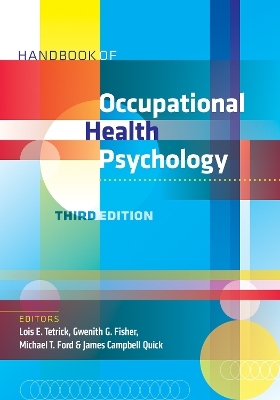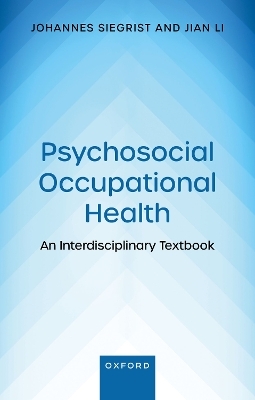
Work Stress Disease and Life Expectancy
Seiten
1991
John Wiley & Sons Ltd (Verlag)
978-0-471-91970-4 (ISBN)
John Wiley & Sons Ltd (Verlag)
978-0-471-91970-4 (ISBN)
- Titel ist leider vergriffen;
keine Neuauflage - Artikel merken
Few doubt that psychological factors play an important role in mental health and physical disease, and that occupational stress has significant effects on psychological well-being. This book is an attempt to bridge the gap between the psycho-medical literature and research on occupational stress.
Few doubt that psychological factors play an important role in mental health and physical disease; lay-people place stress and tension above traditional risk factors such as smoking, blood pressure and cholesterol levels as causes of heart attacks. Recent years have also seen an explosion of medical research which takes account of the phychological dimension, and there are many thousands of learned articles on stress and illness. Few people also doubt that occupational stress has significant effects on psychological well-being. The literature on work stress is growing apace, although it has only recently started to take serious account of it's physical disease consequences. This book is an attempt to bridge the gap between the psycho-medical literature and the research on occupation stress. The first chapter outlines and discusses a number of central models of stress,e ither because they hhave been very influential or because they are particularly relevant to the workplace and have been applied to the prediction of illness.
This chapter also describes a new model, the Catastrophe or Configural Model, which attempts to incorporate the advantages of previous models and make new testable predictions. Chapter 2 outlines and evaluates the research on the role of life events in illness. Life events research has contributed a great deal to the area, and the methodologies spawned from it are probably more widespread and influential than at first sight. It is for this reason that the chapter considers life events research from a methodological perspective. The literature has much to teach us about how to tackle (and not tackle) the relationship between stress and health. The chapter also provides a backcloth against which to evaluate some of the life events research detailed in subsequent chapters. The next three chapters considers the research attempting to show that psychological factors compromise the immune system and are implicated in the onset of cancer and coronary heart disease: the two killers responsible for most deaths. Chapter 3 discusses the possible role of psychological factors in immune system functioning.
Although the chapter does include reference to studies relevant to the workplace, the major thrust of it is to convince the reader that psychological stressors can have major health consequences as revealed by direct immunocompetence measures. Without the demonstration of such a link, much of the research investigating stress and disease would be left in a scientifically unacceptable vacuum. This is an exciting area of research for this reason along. It is also in a state of relative infancy. Chapters 4 and 5 pay particular attention to the role played by personality factors in cancer and heart disease. The concept of type A coronary-prone behaviour has received considerable attention in relation to work issues, dispite it's somewhat shakey scientific validity. The relationship between other psychological stressors and disease is also considered in some detail. Chapter 6 attempts to bring the research discussed int he previous chaptes into a wider context by illustrating some of the hidden consequences of work.
It shows how work stress spills over into the home environment and what effects this may have on the well-being and life expectancy of marital partners, and tries to show that specific disease risks may be communicated through psychological mechanisms. It reinforces the view that the distinction between work and home may not be very clear-cut in terms of health effects. Chapter 7 is a rather descriptive chapter which provides information on the epidemiology of illness with specific reference to work: how many people in a workforce are likely to be suffering at any point in time, and what level in the organization they will be at. A version of this chapter has been published before (Fletcher, 1988a), although this has been expanded and updated.
Few doubt that psychological factors play an important role in mental health and physical disease; lay-people place stress and tension above traditional risk factors such as smoking, blood pressure and cholesterol levels as causes of heart attacks. Recent years have also seen an explosion of medical research which takes account of the phychological dimension, and there are many thousands of learned articles on stress and illness. Few people also doubt that occupational stress has significant effects on psychological well-being. The literature on work stress is growing apace, although it has only recently started to take serious account of it's physical disease consequences. This book is an attempt to bridge the gap between the psycho-medical literature and the research on occupation stress. The first chapter outlines and discusses a number of central models of stress,e ither because they hhave been very influential or because they are particularly relevant to the workplace and have been applied to the prediction of illness.
This chapter also describes a new model, the Catastrophe or Configural Model, which attempts to incorporate the advantages of previous models and make new testable predictions. Chapter 2 outlines and evaluates the research on the role of life events in illness. Life events research has contributed a great deal to the area, and the methodologies spawned from it are probably more widespread and influential than at first sight. It is for this reason that the chapter considers life events research from a methodological perspective. The literature has much to teach us about how to tackle (and not tackle) the relationship between stress and health. The chapter also provides a backcloth against which to evaluate some of the life events research detailed in subsequent chapters. The next three chapters considers the research attempting to show that psychological factors compromise the immune system and are implicated in the onset of cancer and coronary heart disease: the two killers responsible for most deaths. Chapter 3 discusses the possible role of psychological factors in immune system functioning.
Although the chapter does include reference to studies relevant to the workplace, the major thrust of it is to convince the reader that psychological stressors can have major health consequences as revealed by direct immunocompetence measures. Without the demonstration of such a link, much of the research investigating stress and disease would be left in a scientifically unacceptable vacuum. This is an exciting area of research for this reason along. It is also in a state of relative infancy. Chapters 4 and 5 pay particular attention to the role played by personality factors in cancer and heart disease. The concept of type A coronary-prone behaviour has received considerable attention in relation to work issues, dispite it's somewhat shakey scientific validity. The relationship between other psychological stressors and disease is also considered in some detail. Chapter 6 attempts to bring the research discussed int he previous chaptes into a wider context by illustrating some of the hidden consequences of work.
It shows how work stress spills over into the home environment and what effects this may have on the well-being and life expectancy of marital partners, and tries to show that specific disease risks may be communicated through psychological mechanisms. It reinforces the view that the distinction between work and home may not be very clear-cut in terms of health effects. Chapter 7 is a rather descriptive chapter which provides information on the epidemiology of illness with specific reference to work: how many people in a workforce are likely to be suffering at any point in time, and what level in the organization they will be at. A version of this chapter has been published before (Fletcher, 1988a), although this has been expanded and updated.
| Erscheint lt. Verlag | 15.7.1991 |
|---|---|
| Reihe/Serie | Wiley Series on Studies in Occupational Stress |
| Zusatzinfo | references, index |
| Verlagsort | Chichester |
| Sprache | englisch |
| Maße | 158 x 235 mm |
| Gewicht | 540 g |
| Themenwelt | Geisteswissenschaften ► Psychologie ► Arbeits- und Organisationspsychologie |
| Medizin / Pharmazie ► Medizinische Fachgebiete ► Arbeits- / Sozial- / Umweltmedizin | |
| Studium ► Querschnittsbereiche ► Klinische Umweltmedizin | |
| Studium ► Querschnittsbereiche ► Prävention / Gesundheitsförderung | |
| ISBN-10 | 0-471-91970-5 / 0471919705 |
| ISBN-13 | 978-0-471-91970-4 / 9780471919704 |
| Zustand | Neuware |
| Informationen gemäß Produktsicherheitsverordnung (GPSR) | |
| Haben Sie eine Frage zum Produkt? |
Mehr entdecken
aus dem Bereich
aus dem Bereich
Buch | Softcover (2023)
American Psychological Association (Verlag)
125,95 €
An Interdisciplinary Textbook
Buch | Softcover (2024)
Oxford University Press (Verlag)
49,85 €

